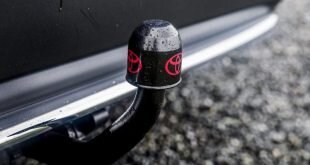Tow and go: essential towing advice

For many people this year, vacations became staycations and boarding passes were swapped for tow bars.
With an increase in interest and enthusiasm for camping and caravanning, we’ve teamed up with Toyota to put together some top tips for anyone planning to tow a caravan or trailer:
Is your vehicle legally permitted to tow?
Your vehicle’s maximum towing capacity can be calculated by deducting the gross vehicle weight (found on the data sticker inside the door frame) from the weight of your caravan or trailer weight. As a guideline, if the weight of the caravan is up to 85 per cent of the kerb weight of the car, it can be towed easily. If it is between 85 and 100 per cent of the kerb weight, it’s recommended the driver has good experience of towing.
Are you legally qualified to tow?
It is also vital to know whether you are qualified to tow. This depends on when you passed your driving test, the weight of your car and what you are towing. You can find the current UK rules and restrictions here.
Is your trailer or caravan roadworthy?
You should carry out regular checks on your caravan or trailer’s brakes, tyres and lights, just as you would check your car. This is particularly important as these vehicles often sit unused for long periods of time. It’s a good idea to make regular short journeys with your trailer to check everything is running smoothly, to prevent brakes from seizing and to ensure the weight of the towed vehicle isn’t placed on the same section of the tyres when parked up.
Nose weight
The nose weight is the maximum vertical load that can be exerted on the tow bar by the attached trailer or caravan (it also applies to tow bar-mounted cycle carriers). You can use a nose weight gauge to check the figure for your caravan or trailer, available from most caravan dealers or online websites.
Routine
It’s good practice to follow a set routine when hitching and unhitching a trailer or caravan, for example: attach tow bar, connect safety cable, connect electric cable, release trailer hand brake. This reduces the chances of you forgetting a step in the process.
Cable checks
Before setting off, check the electric cable and ask another person to stand by the trailer to check the brake lights, indicators and hazard lights are all working properly. The breakaway safety cable should also be checked and re-checked, because in the event of the tow bar becoming unhitched, it will prevent the towed vehicle from potentially rolling and causing an accident.
Additional number plate
It is a legal requirement to have a registration plate attached to your trailer that matches the one on the vehicle towing it.
Key documents
It is important to know whether your breakdown cover includes any vehicles being towed. Keep the relevant documents to hand when making your journey.
Extended Door mirrors
Towing anything behind your vehicle will increase rear-view blind spots. Using extended door mirrors can help improve visibility.
It is not all plain trailing
Towing is not a simple driving skill, you need to be able to handle the extra weight and longer length involved, particularly when turning or reversing. If you are new to towing, or want to brush up your skills, seek advice and training from experts. If you’re towing trailers with live animals, such as horses, here are few tips from the British Horse Society (BHS):
Just in case
Carry spare water, feed and roughage in case of a breakdown or delays. Be careful if you load this in the front of the trailer that you don’t exceed the nose weight.
Keeping your horse safe
When on a motorway or a major A road, don’t unload your horse unless the police or agencies have granted permission.
Loading
If you are travelling with one horse, load it on the right-hand side of the trailer; with two horses, the heavier one should be on the right. For more information and guidance on travelling with horses, check this guide for horsebox and trailer owners

